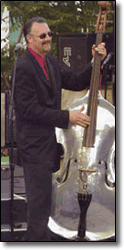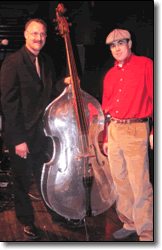|
 By
Cornbread By
Cornbread
An
aluminum bass? That's right—aluminum.
 The
first reported appearance of an aluminum instrument
dates back to 1891, when Alfred Springer of
Cincinnati, Ohio, was awarded a patent for an
aluminum violin. Three years later, in 1894,
the Aluminum Musical Instrument Company of Ann
Arbor, Michigan, was formed under the guidance
of Neil Merrill. The Aluminum Musical Instrument
Company offered everything from violins and
cellos to banjos and zithers. By 1898, the company
had gone broke and subsequently disappeared
from sight. The
first reported appearance of an aluminum instrument
dates back to 1891, when Alfred Springer of
Cincinnati, Ohio, was awarded a patent for an
aluminum violin. Three years later, in 1894,
the Aluminum Musical Instrument Company of Ann
Arbor, Michigan, was formed under the guidance
of Neil Merrill. The Aluminum Musical Instrument
Company offered everything from violins and
cellos to banjos and zithers. By 1898, the company
had gone broke and subsequently disappeared
from sight.
During the mid 1930’s American Aluminum
Company (Buffalo, NY) produced aluminum upright
basses. The entire body, neck and scroll were
made out of seamlessly welded aluminum and often
covered with a faux woodgrain finish. In a reprint
from The Etude Music Magazine, May 1932 an article
mentions that the United States was first to
create an all-metal double bass.
 There
are a couple of stories about why these basses
were made. Some thought that Joseph Maddy of
the National High School Orchestra suggested
aluminum basses be made for schools and orchestral
camps to stand the test of time as opposed to
their older brother the wooden bass that would
often end up unplayable due to cracks. There
are a couple of stories about why these basses
were made. Some thought that Joseph Maddy of
the National High School Orchestra suggested
aluminum basses be made for schools and orchestral
camps to stand the test of time as opposed to
their older brother the wooden bass that would
often end up unplayable due to cracks.
The same article states “the aluminum
bass has many advantages over the wood bass,
in that it cannot crack, split or warp, and
is made to last forever. It is as light in weight
as a wooden bass, and has a tone that is deep,
resonant and of cello-like purity. It is made
in silver or gold aluminum finish, or natural
wood finish, patterned after a fine old bass
made by Stradivarius.”
The
other belief is that Ford Motor Company produced
a limited number of aluminum basses for the
Navy as a wooden bass could not survive extended
travels on the ships as they are resistant to
humidity and moisture.
 This
leads us to the only aluminum bass I have seen,
for that matter knowingly heard on a CD or live.
The one played by Mike Graham of Hudson
and the Hoo Doo Cats. I spoke to Mike and
Hudson Harkins about the prized bass. This
leads us to the only aluminum bass I have seen,
for that matter knowingly heard on a CD or live.
The one played by Mike Graham of Hudson
and the Hoo Doo Cats. I spoke to Mike and
Hudson Harkins about the prized bass.
Both fellows were happy with the low-end response
and agreed that the aluminum bass had more sustain
and punch than the wooden counterpart they started
with.
Mike purchased this bass in 2001, he said “it
was tarnished, corroded and looked like a bucket.”
The bass was originally set-up for blue grass
and had remnants of the faux wood. Graham and
Hudson believe its origin to be a late 30’s
or early 40’s Ford.
Mike has been keeping a list of things asked
or comments heard at every show, the list is
(in no specific order):
•
What is that?
• Is that a cello?
• Why did you paint your bass?
• Did you make that?
• Is that metallic?
• How did you get that metal over the
wood?
• Is it heavy?
• How does the metal affect the sound?
• The top question the drummer gets –
What’s that sound?
For
all you in St. Louis I suggest you check out
a live show and hear this bass for yourself,
for everyone else, buy the CD’s.
Ciao’
for now, peace.
Cornbread
©
2005, Peter ‘Cornbread’ Cohen &
STLBlues.net
|

